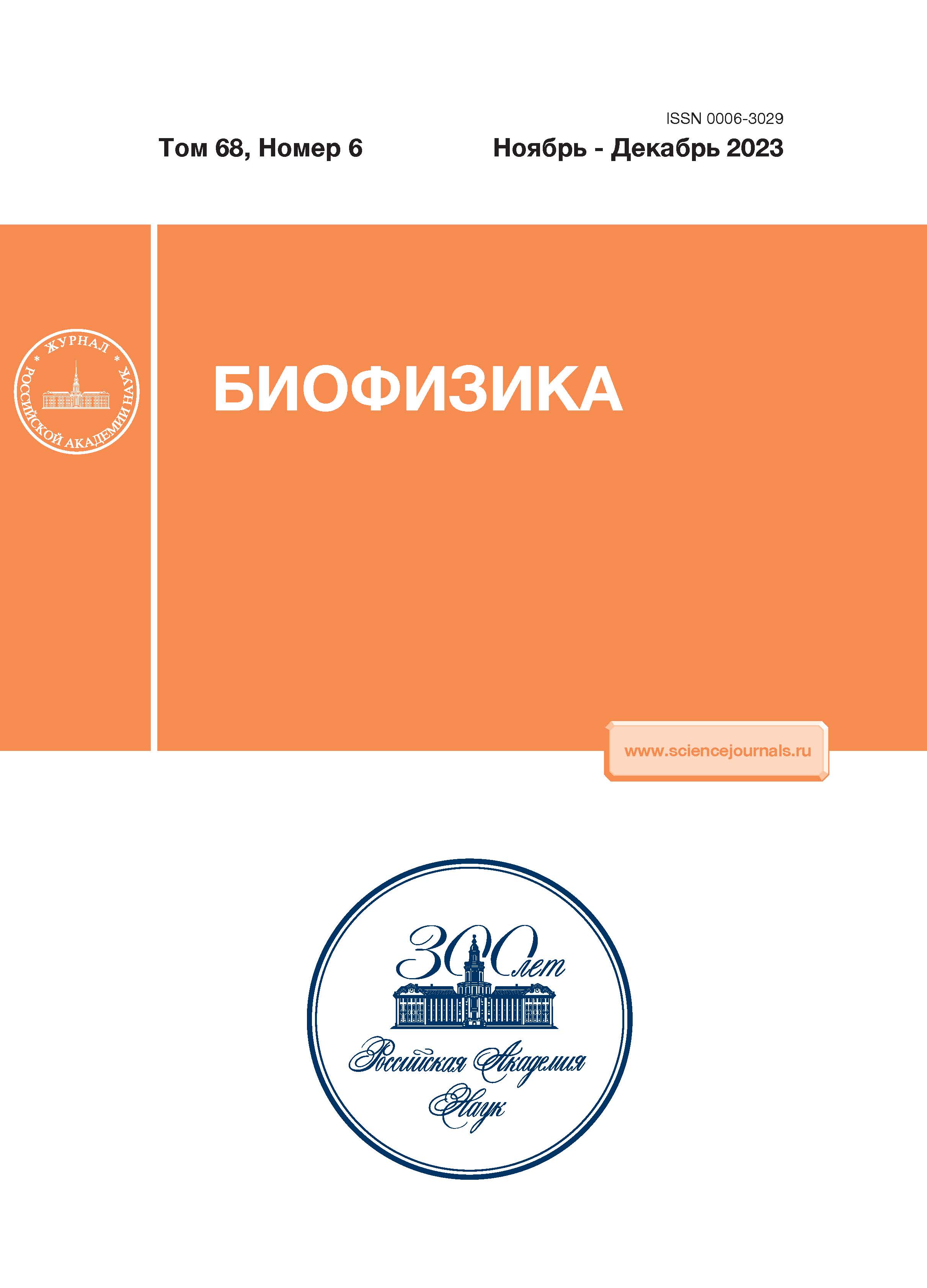About the pathway of amyloid aggregation of titin
- Autores: Bobyleva L.G1, Uryupina T.A1, Timchenko M.A1, Udaltsov S.N2, Vikhlyantsev I.M1,3, Bobylev A.G1
-
Afiliações:
- Institute of Theoretical and Experimental Biophysics, Russian Academy of Sciences
- Institute of Physicochemical and Biological Problems of Soil Science, Russian Academy of Sciences
- Institute of Fundamental Medicine and Biology, Kazan Federal University
- Edição: Volume 68, Nº 6 (2023)
- Páginas: 1303-1310
- Seção: Articles
- URL: https://kld-journal.fedlab.ru/0006-3029/article/view/673266
- DOI: https://doi.org/10.31857/S0006302923060212
- EDN: https://elibrary.ru/PSSSND
- ID: 673266
Citar
Texto integral
Resumo
Palavras-chave
Sobre autores
L. Bobyleva
Institute of Theoretical and Experimental Biophysics, Russian Academy of SciencesPushchino, Moscow Region, Russia
T. Uryupina
Institute of Theoretical and Experimental Biophysics, Russian Academy of SciencesPushchino, Moscow Region, Russia
M. Timchenko
Institute of Theoretical and Experimental Biophysics, Russian Academy of SciencesPushchino, Moscow Region, Russia
S. Udaltsov
Institute of Physicochemical and Biological Problems of Soil Science, Russian Academy of SciencesPushchino, Moscow Region, Russia
I. Vikhlyantsev
Institute of Theoretical and Experimental Biophysics, Russian Academy of Sciences;Institute of Fundamental Medicine and Biology, Kazan Federal UniversityPushchino, Moscow Region, Russia;Kazan, Russia
A. Bobylev
Institute of Theoretical and Experimental Biophysics, Russian Academy of Sciences
Email: bobylev1982@gmail.com
Pushchino, Moscow Region, Russia
Bibliografia
- C. Li, J. Adamcik, and R. Mezzenga, Nat. Nanotechnol., 7 (7), 421 (2012). doi: 10.1038/nnano.2012.62
- R. Nelson, M. R. Sawaya, M. Balbirnie, et al., Nature, 435 (7043), 773 (2005).
- M. R. Sawaya, S. Sambashivan, R. Nelson, et al., Nature, 447 (7143), 453 (2007). doi: 10.1038/nature05695
- D. Eisenberg and M. Jucker, Cell, 148 (6), 1188 (2012). doi: 10.1016/j.cell.2012.02.022
- H. Wille, W. Bian, M. McDonald, et al., Proc. Natl. Acad. Sci. USA, 106 (40), 16990 (2009). doi: 10.1073/pnas.0909006106
- T. P. Knowles, A. W. Fitzpatrick, S. Meehan, et al., Science. 318 (5858), 1900 (2007). doi: 10.1126/science.1150057
- S. Keten and M. J. Buehler, Nano Lett., 8 (2), 743 (2008). doi: 10.1021/nl0731670
- F. S.Ruggeri, J. Adamcik, J. S. Jeong, et al., Angew Chem.Int. Ed. Engl. 54 (8), 2462 (2015). doi: 10.1002/anie.201409050
- V. N. Uversky, FEBS J., 277, 2940 (2010).
- C. B. Anfinsen, Science, 181, 223 (1973).
- M. Vendruscolo and C. M. Dobson, Philos. Trans. A. Math. Phys. Eng. Sci., 363, 433 (2005).
- P. G. Wolynes, Philos. Trans. A. Math. Phys. Eng. Sci., 363, 453 (2005).
- J. C. Rochet and P. T. Lansbury Jr, Curr. Opin. Struct. Biol., 10, 60 (2000).
- T. R. Jahn, S. E. Radford, FEBS J., 272 (23), 5962 (2005). doi: 10.1111/j.1742-4658.2005.05021.x
- V. Daggett and A. R. Fersht, Trends Biochem. Sci., 28, 18 (2003).
- A. R. Fersht, Proc. Natl. Acad. Sci. USA, 97, 1525 (2000).
- S. E. Radford, C. M. Dobson, and P. A. Evans, Nature, 358, 302 (1992)
- D. Baram and A. Yonath, FEBS Lett., 579, 948 (2005).
- T. M. Phan and J. D. Schmit. Biophys J., 121 (15), 2931 (2022). doi: 10.1016/j.bpj.2022.06.031
- V. N. Uversky and A. L. Fink, Biochim. Biophys. Acta, 1698, 131 (2004).
- J. K. Freundt and W. A. Linke, J. Appl. Physiol., 126 (5), 1474 (2019). doi: 10.1152/japplphysiol.00865.2018.
- I. M. Vikhlyantsev and Z. A. Podlubnaya, Biophys. Rev., 9 (3), 189 (2017). doi: 10.1007/s12551-017-0266-6
- K. Kim and T. C. Keller 3rd, J. Cell Biol., 156 (1), 101 (2002). doi: 10.1083/jcb.200107037
- A. G. Bobylev, O. V. Galzitskaya, R. S. Fadeev, et al., Biosci. Rep. Biosci Rep., 36 (3), e00334 (2016). doi: 10.1042/BSR20160066
- E. I. Yakupova, I. M. Vikhlyantsev, L. G. Bobyleva, et al., J. Biomol. Struct. Dyn., 36 (9), 2237 (2018). doi: 10.1080/07391102.2017.1348988
- A. G. Bobylev, E. I. Yakupova, L. G. Bobyleva, et al., Mol. Biol. (Moscow), 54 (4), 643 (2020). doi: 10.31857/S0026898420040047
- A. G. Bobylev, E. I. Yakupova, L. G. Bobyleva, et al., Int. J. Mol Sci., 24 (2), 1056 (2023). doi: 10.3390/ijms24021056
- M. R. Krebs, G. L. Devlin, and A. M. Donald, Biophys. J., 96 (12), 5013 (2009).
- H. H. J. de Jongh, T. Groneveld, and J. de Groot, J. Dairy Sci., 84, 562 (2001).
- M. R. H. Krebs, E. H. C. Bromley, S. S. Rogers, and A. M. Donald, Biophys. J., 88, 2013 (2005).
- M. B. Borgia, A. A. Nickson, J. Clarke, M. J. Hounslow., J. Am. Chem. Soc., 135 (17), 6456 (2013). doi: 10.1021/ja308852b
- A. Borgia, K. R. Kemplen, M. B. Borgia, et al., Nat.Commun., 6, 8861 (2015).
- H. Lu, B. Isralewitz, A. Krammer, et al., Biophys. J., 75 (2), 662 (1998). doi: 10.1016/S0006-3495(98)77556-3
- J. Waeytens, J. Mathurin, A. Deniset-Besseau, et al., Analyst, 146 (1), 132 (2021). doi: 10.1039/d0an01545h
- E. C. Eckels, S. Haldar, R. Tapia-Rojo, et al., Cell Rep., 27, 1836 (2019).
- J. A. Rivas-Pardo, E. C. Eckels, I. Popa, et al., Cell Rep., 14, 1339 (2016).
- S. Kumar and J. Walter, Aging (NY), 3 (8), 803 (2011). doi: 10.18632/aging.100362
- J. Gsponer and M. Vendruscolo, Prot. Pept. Lett., 13 (3), 287 (2006). doi: 10.2174/092986606775338407
- T. Eichner and S. E. Radford, Mol. Cell., 43 (1), 8 (2011). doi: 10.1016/j.molcel.2011.05.012
- K. W. Tipping, P. van Oosten-Hawle, E. W. Hewitt, and S. E. Radford, Trends Biochem. Sci., 40 (12), 719 (2015). doi: 10.1016/j.tibs.2015.10.002
- A. K. Buell, A. Dhulesia, D. A. White, et al., Angew Chem.Int. Ed. Engl., 51 (21), 5247 (2012). doi: 10.1002/anie.201108040
- A. J. Baldwin, T. P. Knowles, G. G. Tartaglia, et al., J. Am. Chem. Soc., 133 (36), 14160 (2011). doi: 10.1021/ja2017703
- E. Gazit, Angew Chem.Int. Ed. Engl., 41 (2), 257 (2002). doi: 10.1002/1521-3773(20020118)41: 2<257::aid-anie257>3.0.co;2-m
Arquivos suplementares










